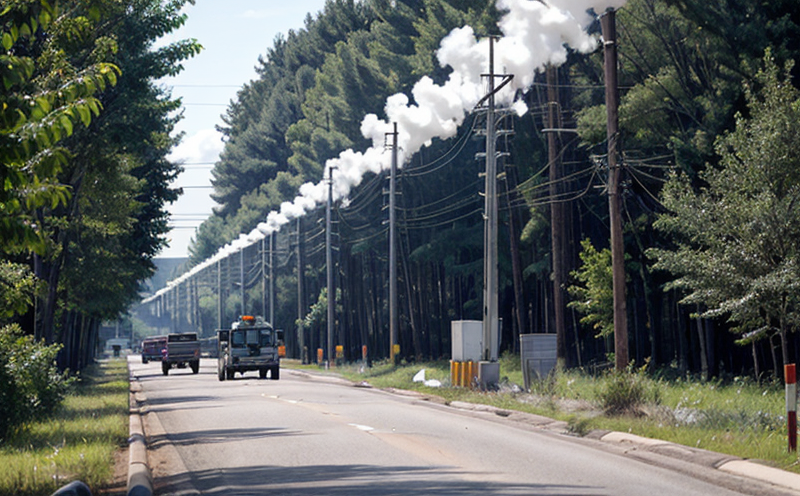ISO 10849 Stack Gas Emission Sampling Testing
The ISO 10849 standard is a cornerstone in the field of environmental and emission compliance testing, particularly relevant for the power & utilities sector. This standard outlines the methods for sampling stack gases to determine emissions levels. Compliance with this standard ensures that industrial facilities are meeting international standards set forth by the International Organization for Standardization (ISO).
Power plants and utility companies are required to monitor their exhaust gas emissions closely due to stringent environmental regulations aimed at reducing air pollution and mitigating climate change impacts. The ISO 10849 stack gas emission sampling testing is crucial in this context, as it helps utilities understand the composition of their exhaust gases and identify areas for improvement.
The process typically involves collecting a representative sample from the exhaust stack using a specialized probe or canister sampler. This sample is then analyzed to determine its chemical constituents and concentrations. The types of pollutants that are commonly tested include sulfur dioxide (SO₂), nitrogen oxides (NOₓ), particulate matter, volatile organic compounds (VOCs), and carbon monoxide.
The testing process begins with the installation of sampling equipment at various points within the stack to ensure a representative sample is collected. Factors such as the velocity of the gas stream, temperature, and pressure are carefully considered during this phase to ensure that the sample accurately reflects the emissions from the entire facility.
Following specimen preparation, which involves conditioning the sample for analysis, the next step is instrumental analysis. This can be done using a range of analytical techniques depending on the specific pollutants being measured. For instance, gas chromatography and mass spectrometry are often used to identify complex organic compounds, while electrochemical sensors may be employed for simpler inorganic species.
The results from these analyses provide critical data that help utilities make informed decisions about their emissions control strategies. By adhering to ISO 10849 standards, power & utilities companies can demonstrate compliance with local and international regulations, thereby reducing the risk of regulatory penalties and enhancing their environmental reputation.
Compliance with this standard also offers broader benefits such as improved operational efficiency, reduced maintenance costs due to better understanding of wear-and-tear patterns related to emissions, and enhanced public relations through transparent reporting practices. These aspects make ISO 10849 stack gas emission sampling testing an indispensable part of any comprehensive environmental management strategy for the power & utilities sector.
Applied Standards
The ISO 10849 standard is widely recognized and applied across various sectors, including power & utilities. It provides a robust framework for sampling stack gases to assess emissions levels accurately. This ensures that the data collected can be used reliably in regulatory compliance activities.
- ISO 10849-2: Sampling of gaseous pollutants from stationary sources
- ISO 10849-3: Determination of carbon monoxide (CO) and hydrogen (H₂)
- ISO 10849-4: Determination of sulfur dioxide (SO₂)
- ISO 10849-5: Determination of nitrogen oxides
- ISO 10849-6: Determination of volatile organic compounds (VOCs) by gas chromatography-mass spectrometry
The application of these specific standards within the ISO 10849 framework allows for precise and accurate measurement of various pollutants, ensuring comprehensive coverage of all significant emission sources.
Eurolab Advantages
At Eurolab, our expertise in conducting ISO 10849 stack gas emission sampling testing is unmatched. Our team of experienced professionals ensures that every aspect of the testing process meets or exceeds industry standards.
- Experienced Staff: Our team comprises highly trained and certified specialists who are well-versed in all aspects of ISO 10849 compliance.
- State-of-the-Art Equipment: We utilize the latest technology to ensure accurate and reliable sampling, including advanced canister samplers and real-time gas analyzers.
- Comprehensive Reporting: Our detailed reports provide a clear understanding of the testing results, helping clients make informed decisions about their emissions control strategies.
- Regulatory Compliance: We ensure that all tests are conducted in full accordance with ISO 10849 standards, guaranteeing compliance with international regulations.
Our commitment to excellence and our unwavering dedication to customer satisfaction have made us a trusted name in the industry. With Eurolab, you can rest assured that your ISO 10849 stack gas emission sampling testing will be conducted to the highest standards.
Quality and Reliability Assurance
- Data Integrity: Our rigorous quality assurance protocols ensure that all data collected during ISO 10849 stack gas emission sampling testing is accurate, reliable, and free from errors.
- Consistent Reporting: We provide consistent reports across multiple test runs to help identify trends in emissions over time.
- Continuous Improvement: Our commitment to continuous improvement ensures that our methods remain at the forefront of technological advancements.
In addition to these listed advantages, we also offer regular calibration checks and method validation exercises to maintain the highest standards of reliability and accuracy in our testing processes.





